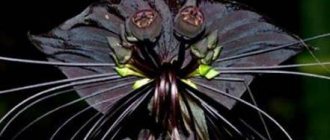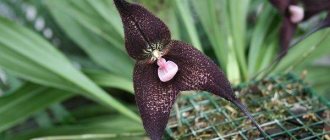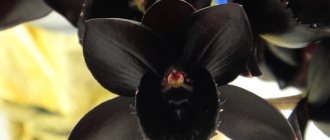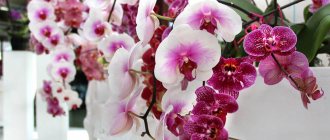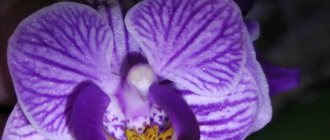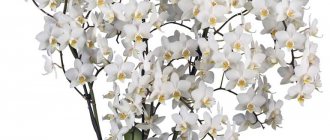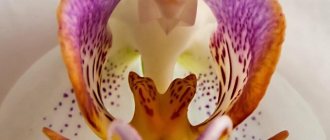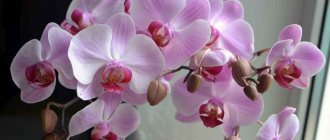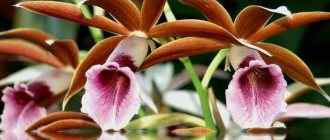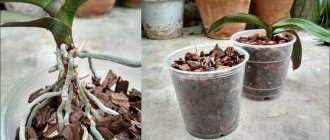Characteristics of black orchid
With regard to indoor floriculture, the Phalaenopsis genus is the most common of the Orchidaceae family. Their popularity is due to the fact that representatives of the genus are quite easy to care for. This genus has about fifty different species, all of tropical origin. Phalaenopsis orchids grow in exotic countries such as Taiwan, the Philippines and Australia.
Orchids are never completely black
The black orchid is an original flower. However, there is not much true black in nature. In fact, this shade is provided by special blue or purple pigments. Phalaenopsis black up close turns out to be dark burgundy or dark purple. But these flowers are still beautiful.
It is not surprising that Tom Ford created his famous perfume “Black Orchid” based on the smell of black orchid. Ford's Orchid is not even a fragrance, but a step towards bohemian luxury. It is worth noting that plants can have different shades. For example, Phalaenopsis variety Black Pearl may have pinkish-red, burgundy or dark purple petals.
Description and popular types
There is no consensus on how the black orchid appeared, both among researchers and flower growers. Some, for example, believe that the flower was stolen by George Cranleith from a South African tribe.
Others believe that the culture was artificially created by crossing several types of phalaenopsis. This process is quite expensive and lengthy, which can explain the scarcity of the flower. In addition, the hybrid phalaenopsis orchid has a rich vanilla aroma, which is its specific characteristic. Only such a plant can rightfully be called “black”. And the black flowers obtained after injecting paint into the bud are just a cheap fake.
Most, unfortunately, consider themselves the owners of a black orchid with a large flower, but this is wrong. In most cases, a burgundy or dark purple orchid is mistaken for such a flower.
The ink-colored Takka flower is often referred to as Phalaenopsis, which, however, has nothing to do with this family of plants.
The most common types of black phalaenopsis orchids are:
- Maxillaria schunkeana. The species is quite rare, this orchid is a rich dark color;
- Fredclarkeara After Dark Black Pearl - The plant is covered with dark blue flowers, which are often considered black. Sometimes these flowers are even called “Black Prince”;
- Paphiopedilum Pisgah Midnight. Flowers of this species have dark veins on their petals, reminiscent of tiger stripes. Therefore, the flower is called “tiger” or “tiger”;
- Phalaenopsis Black Butterfly Orchids. The shape of a flower of this species resembles the wingspan, which is why it is often called a “bird” or “butterfly”. Its color is deep burgundy or purple. Occasionally the petals are covered with white spots;
- Paphiopedilum de Nachtwacht - the petals of the flower of this species are burgundy with a black tint;
- Dracula roezlii. This orchid has deep dark, almost black petals, which are dotted with small light spots.
Common varieties and varieties
Phalaenopsis orchid: main types and home care options
Even the so-called black orchids exist in several varieties and varieties.
Orchid Black Pearl
They differ in appearance and sometimes are completely different from each other. The most popular ones are presented below.
- Black bird
It has a rich blueberry hue. The flowers are located on one peduncle, they are large, with a waxy gloss. Flowering is very spectacular and long lasting.
- Black Prince
It has an almost inky tint. A characteristic feature is white spots in the center.
It can reach a height of up to 50 cm, the diameter of the flower is no more than 7 cm.
For reference! The number of colors Black prince has depends on the conditions of detention.
- Black Pearl
This black phalaenopsis orchid is the fruit of careful selection. Its flowers have a very unusual shape; the plant forms up to 4 peduncles. The color is burgundy with a slight purple tint, the leaves are a rich emerald color.
- Black Widow
A very attractive plant. The shade is very juicy, colorful, and you just want to touch the petals. The black orchid flower has an elegant shape.
- Not the most famous varieties of black orchid
Black Trevor, Black Mamba and Black Swan orchids are quite interesting varieties.
Orchid Black Trevor
They all need proper care, without which they will not be as attractive.
Kaoda Orchid: what you need to know about growing
Phalaenopsis Kaode is a black orchid hybrid with a white lip. Despite its short existence in the “flower world,” the heterotic hybrid has a large number of subspecies and varieties. In order for an orchid to delight with long-lasting and high-quality flowering, it needs to be provided with proper care.
Description of the plant
Kaodu is called "black orchid", but this name does not correspond to the actual color of the plant. This “black” effect is achieved due to the richness of burgundy, purple and beetroot colors. The petals are highly dense and saturated with wax, so they seem to shine and shimmer in the light.
The height of the orchid is considered average - the stem can grow up to 0.2 meters and is usually completely hidden by leaf plates. The leaves, in turn, can reach 22 centimeters in length and 8-10 centimeters in width. The shade of the leaf blades is very rich, thick, dark green. Sometimes the leaves can be smaller in size, but this usually happens in young plants.
The flower arrow grows from a leaf rosette. Sometimes the peduncle is branched. In most cases, Kaoda has two peduncles. Up to a dozen flowers can bloom on one such arrow; with proper care, there can be fifteen buds. The diameter of the flowers is 4-5 centimeters.
The buds have petals of regular shape, beet or purple in color. In some cases, petals with a white border are found. The lip is white, in rare cases with purple splashes. At the end the lip bifurcates.
There is no dormant period for this orchid variety; it can bloom all year round. However, most often the buds bloom in the spring-summer season. The aroma is light but pleasant. Reveals in the morning and evening, and during daylight hours it is perceived neutrally. As air humidity increases, the odor increases.
Kaoda’s “parents” were Phalaenopsis Schiller and Malva Rose Valentain Pearl, beloved by flower growers.
Differences from other types
The epiphytic plant has about 39 species, which are characterized by:
- powerful, not very long stem;
- wide leaf blades that do not change color throughout their existence;
- aerial root system;
- tall peduncles with butterfly flowers.
The main difference between the Kaoda orchid hybrid is the color of the petals. However, the flowers differ from other subspecies of orchids in their dense structure and glossy shine.
Kaoda orchid varieties
Phal kaoda varieties are similar in flower structure, petal color, and leaves.
Chocolate Drops
This plant has earned its extraordinary popularity among orchid breeders due to its unique smell and original colors. The aroma is pronounced, the fragrance is felt throughout the day, while the dark purple bud with a light border is open. The lip stands out against the background of the sepals in white. The green plates are strong and elastic, but grow no longer than 15 cm.
Black Butterfly
A standard with petals resembling the wings of a moth (cherry color). It is distinguished by a large number of buds on one arrow. The delicate white specks on the original lip give the plant a special sophistication.
Twinkle
A hybrid created on the basis of Phalaenopsis Kaoda with bright burgundy fleshy petals. The stem of the plant reaches a length of 19 cm-25 cm, leaf blades - 21 cm-28 cm. An abundantly flowering hybrid that smells only at high humidity.
Black Prince
The amazing darkness of the color is diluted by a barely noticeable white border. The non-standard shaped lip looks like an open pharynx with yellow streaks and spots to match the sepals. This standard is distinguished by its high growth - up to 55 cm, and the diameter of the open buds ranges from 4 to 5 cm. The number of ovaries directly depends on the conditions of detention.
Features of flowering
As already mentioned, Kaoda can bloom buds at any time of the year, and flowering usually continues for a long time. Often in the spring the growth of buds and flower stalks begins.
Phal kaoda will delight you with its flowering if you follow simple rules:
- maintaining proper watering;
- installing the plant in a place where the sun's rays will not reach;
- increasing daylight hours in the autumn-winter period using fluorescent or phyto lamps;
- moderate feeding.
Conditions of detention
Despite the plant’s stable immunity, it is worth knowing that Kaoda should not be fed during the flowering period. If fertilizer is applied while the flowers are blooming, the hybrid will bloom very quickly and shed unopened buds.
After flowering, give the hybrid a forced rest period of two to three weeks. At this time, reduce watering by three times and do not apply fertilizers.
If there are no buds
Kaoda is a very capricious plant regarding the temperature of its content and requires a lot of heat. In summer, the temperature should fluctuate between 25-33 degrees above zero, and in winter - 16-21 degrees Celsius. Do not forget about daily temperature changes - the difference should be approximately 3-5 degrees.
Despite the fact that this variety can bloom constantly, it is better to give the plant a month’s rest at least once a year. At this time, Kaoda will gain strength for new flowering.
How to properly care
Competent and timely care of the orchid is the key to its stable development and regular flowering. Improper watering, for example, can result in rotting of the trunk or roots, and dry air can lead to an invasion of parasites.
Lighting
It is best if the pot is on the west or east side of the room. To prevent ultraviolet burns from appearing on the foliage, cover the windows with loose curtains or blinds. To ensure that the trunk grows symmetrically, without reaching for the sun, rotate the pot occasionally.
In the summer months, the best source of lighting for Kaoda will not be the hot morning rays, but the muted light of the setting sun. Placing phalaenopsis on southern windows is allowed only if the glass is completely shaded.
In winter, plants can also be placed on the south side of the room.
It is worth remembering that in short-day conditions, the crop will need to be illuminated with fluorescent lamps so that the illumination per day is at least 13 hours.
The height between the fluorescent lamp and the trunk with additional lighting should be at least 25 cm. If the lamp is installed very close, the plant will receive thermal burns.
Temperature
To provide good conditions for the growth, development and lush flowering of the “dark beauty”, you need to adhere to a temperature range of +17 to +26 degrees. The plant can tolerate heat and low temperatures for several days. However, you should not take risks, since deviations from normal temperatures for five to six days will lead to the death of the flower.
Do not try to warm the orchid using heating devices. Thus, the air around and the plant itself will simply begin to dry out.
Humidity
Since the homeland of this plant is tropical forests, the air around the flower should be well humidified. This can be done by simply spraying both Kaoda itself and the space around it. But when spraying the plant, it is important to ensure that drops of water do not fall on the buds and leaf rosette.
Another way to provide moist air is to place a container of water near the flower.
Watering
Watering directly depends on how the orchid is kept and the season. When planting Kaoda on a block, you need to water it every day, especially on hot summer days. If the orchid grows in a pot or basket, it needs to be watered once every 5 to 7 days. This variety is very resistant to drying and can remain unwatered for a long time.
During watering, carefully protect the rosettes and leaf axils so that water does not get there. Stagnation of water in these places can lead to rotting and further death. Immediately after watering, you can place the orchid under a fan, then all excess moisture will evaporate and will not cause harm.
- In spring and hot summer. Once a week, spill the soil with warm water on top of the pot, preventing water from accumulating. Soaking in water is not recommended. It is best to water in the morning. It is necessary to water only when all the roots have become a uniform silver-gray color.
- In autumn and winter. More rare and careful watering, approximately once every 10-14 days.
Feeding
It is recommended to add additional nutrition twice a month, but this is allowed only during the period of active growth of the orchid. During flowering, Kaoda does not need feeding ─ such manipulation can lead to buds falling off and shortening the flowering period. Fertilizer application is combined with watering to prevent root burns.
In rooms with high humidity and lighting for at least 20 hours a day, the hybrid is fed every week, reducing the dosage by half. Hybrids with this feeding method produce a large number of flowers, up to 70 pieces per stem.
The aerial roots of the hybrid directed in different directions indicate that the plant is overfed and there is a large amount of salts in the soil mixture. To wash out impurities, immerse the pots for half an hour in containers with non-chlorinated water.
Transfer
The orchid is replanted when the substrate begins to decompose. Pine bark expires after 30 months. In addition, transplantation is used:
- if the plant is cramped in the pot;
- The orchid is sick and needs root cleaning.
When performing a transplant:
- carefully remove the plant from the pot;
- in order not to injure the roots, the flowerpot can be cut with a hot knife;
- after removing the flower, rinse the roots under running water, cut off the rotten and dried parts;
- Sprinkle the cut areas with powdered activated carbon;
- trim yellowed and dried areas of leaf blades;
- After pruning, place the plant on a clean cloth to dry;
- fill the container in which the orchid will grow with the prepared soil mixture and plant the flower;
- After planting, water the plant and leave it for ten days in a semi-dark place for better survival.
Preparing the soil and pot
The container must be transparent to allow the root system to participate in the process of photosynthesis. It is recommended to purchase flowerpots with smooth walls, since otherwise the roots will grow into the surface of the pot.
It is better to purchase ready-made soil, designed specifically for the Orchid family. But if the grower wants to prepare the substrate himself, then he will need the following components:
- sphagnum moss;
- bark (preferably pine);
- river sand;
- peat.
All this must be mixed in equal proportions. Don't forget also about the drainage layer, which prevents water stagnation.
Possible problems during cultivation
Caring for a hybrid is very simple. However, sometimes gardeners face the following problems:
- yellowing of leaf blades due to lack of moisture or damage by sucking pests;
- swelling of the leaves due to prolonged contact with water;
- cracking of leaf plates due to excess fertilizer;
- falling off of the vegetative part due to lack of light or decreased air temperature;
- frostbite of the plant in winter when ventilating the room.
To avoid such situations, the following preventive measures are recommended:
- do not allow excess nitrogen in the substrate after fertilizing;
- do not spray phalaenopsis in autumn and winter, when the room temperature is low and air ventilation is poor;
- prevent the development of diseases by spraying with fungicides;
- do not allow the root system to overheat.
Diseases and pests
The ailments of all epiphytes are the same, and the treatment is practically no different. The main thing is not to let things get to the point of no return, when you can no longer help the plant.
The spider mite manifests itself as a white and weightless web on the leaves and trunk. The bugs themselves are difficult to notice with the naked eye.
Treatment:
- Rinse the orchid under a warm shower.
- It is easy to wipe the green plates with a damp sponge.
- Spray with acaricide according to the instructions on the package. For epiphytes, the drug Fitoverm is best suited.
- Depending on the complexity of a particular case, you will need from 2 to 4 treatments once a week.
Rot and gray mold appear as a sudden stop in development and dark spots. Only the second one is also shown on the petals, as small black dots. The buds disappear after this. The disease occurs due to waterlogging of the environment at low air temperatures.
Treatment:
- A complete replantation into a new substrate and pot with cleaning of the rhizome and aerial parts from the affected areas is required. All cuts are sprinkled with cinnamon or crushed coal.
- Stop watering and place the plant in a brighter and warmer place. With the latter, the main thing is not to overdo it, otherwise you will only make things worse.
- Treat Kaoda with “Fundazol”, following the recommendations from the manufacturer during the process.
How to propagate
At home, the Kaoda orchid reproduces, like many phalaenopsis, with the help of lateral processes - “babies” on stems or on peduncles. It is important to maintain a temperature of 25°C and humidity of 60%.
The process of separating the “babies”:
- We choose an adult, healthy orchid with good roots and large large leaves. It is important that propagation must take place after flowering, while the peduncle must still be fresh.
- Using a sharp knife, cut the top of the peduncle to the top “dormant” bud, and sprinkle the wound with charcoal.
- We transplant the new shoot into a previously prepared small greenhouse with a substrate - sphagnum (you can use an aquarium).
- We stop watering for several days.
Kaoda orchid is a variety that is more adapted to growing in our conditions. If you follow all the rules of care, the gardener will constantly enjoy the beauty of this plant.
Source: https://rastenia.info/tsvetyi/orhideya/kaoda.html
Planting a plant
Phalaenopsis propagation at home: examples by children and cuttings
General tips and advice for caring for orchids apply to most plants on the market. These impressive flowers require basic care that is not that difficult. However, you need to know their specific preferences, such as amount of watering, required lighting, temperature, type of environment, etc.
Planting in a pot
Phalaenopsis orchids really need light, so you need to find a suitable place for proper flowering. For this reason, it is advisable to place them next to a window or terrace, but without direct rays. The ideal temperature should be around +22 ºC during the day and between +16 ºC and +20 ºC at night.
A plastic pot is usually a good choice because when it comes time to repot the plant, the plastic is much easier to separate and can even be cut off without problems to remove the roots as carefully as possible if necessary.
Attention! You cannot use regular garden soil for potted orchids.
Pre-made substrates are available from nurseries and garden centers and are usually made from cork, white peat, charcoal, vermiculite, polystyrene and coir. What all these materials have in common is that they are spongy, lightweight and resistant, capable of storing water and nutrients, maintaining optimal conditions for caring for orchid roots.
How to care for an exotic beauty
Since the black orchid came to us from the tropics, its cultivation should be treated with care and wisdom. Some species require special care. Still, the basic principles apply to any plant.
Lighting
First of all, they create comfortable conditions for the flower. It develops wonderfully in a warm and bright room. As a rule, flowerpots are placed on window sills. However, leaf plates may suffer from direct sunlight.
At noon, black orchids are moved to shaded areas.
Watering
The main feature of caring for a black orchid is moderate hydration. The plant does not like extremes. It can be damaged by both prolonged drought and abundant watering. Experts advise moistening the plant no more than 3 times a week in the summer. In winter, 1 time per 7 days is enough.
Water the orchid only after the substrate has completely dried. Otherwise, the plant’s root system will suffer from excessive moisture.
Suitable substrate
When choosing soil for any plant, you should consider its origin. The black orchid came to us from the tropics, so the soil must be loose. The most commonly used materials are pine bark, peat moss or vermiculite.
Top dressing
Phalaenopsis needs additional nutrients during budding. In flower shops you can find special fertilizers for orchid plants. Following the instructions, the substance is added to clean, settled water, after which the surface of the substrate is moistened.
Watering
Orchid care at home: options for propagating and planting a flower
Watering is probably one of the most delicate aspects of orchid care. The water should be soft enough to almost completely eliminate tap water, which usually contains diluted salts. They concentrate in the substrate and roots of plants, disrupting their growth and flowering.
Watering the plant
Any description of the watering procedure says that it is advisable to use rainwater. But this is quite difficult, because few people will be able to collect and store water every time it rains.
As a substitute, you can use bottled water with a low content of mineral salts, sodium, and calcium. Orchids usually do not need much water to bloom.
Water should only be applied when the surface of the soil is almost dry. Therefore, you should do this about twice a week in spring and summer, during the hottest months; and once every two weeks in winter and autumn. During the period from March to October, it is advisable to add a small amount of special fertilizers to the water.
To water properly, follow these instructions:
- Orchids prefer a moderately moist substrate because if it is too wet, the roots cannot breathe and will rot.
- It is best to leave the substrate dry, watering it a day later. Therefore, the frequency of watering will depend on the ambient temperature.
- You can tell if the plant needs water if the substrate is dry to the touch or if the roots are whitish. If they are green, then no watering is needed.
- Watering should be plentiful, but without flooding the roots.
- The water should be at room temperature.
You should try not to wet the flowers to avoid stains. It is also necessary to avoid getting water on the surface of the leaves.
Attention! The orchid needs a high level of humidity, ranging from 60 to 80%.
Flowering period
During flowering, all plants are very sensitive to the environment. Therefore, during this period it is necessary to organize good care. Descriptions of varieties do not always give a complete picture of the beauty of certain specimens.
The approximate air temperature should be 22 °C and humidity 40%. To do this, the plant is not only watered abundantly, but also sprayed regularly.
Note! There is a little trick: you can place a bowl of water next to the pots. The moisture will evaporate and humidify the air.
The room with orchids is ventilated once a day. A constant supply of oxygen is important to improve flowering.
Orchids need long daylight hours. To do this, they are placed on the windowsill or illuminated with phytolamps. An orchid needs 12 hours of light per day. It can exude an unobtrusive floral aroma.
Black phalaenopsis is rarely found in collections, but such flowers are very unusual and beautiful. Not only Tom Ford was captivated by this plant. Such flowers can become the pearl of anyone’s home composition.
Reproduction methods
Orchids can be propagated in two ways: cuttings or seeds.
Reproduction methods
Important! There is an opinion that to grow an orchid you can simply pick a leaf. Gardeners who talk about this method are actually mistaken - most likely, they accidentally tore off the leaf along with part of the trunk where the dormant buds were.
Unlike violets, leaves alone are not enough to grow orchids.
Reproduction through cuttings ensures that the new plant has the same genetic characteristics as its parent. The samples raised through seeds are not identical. Some species of the genus Dendrobium and Phalaenopsis themselves form small new plants.
Aerial roots emerge from the stem. When the roots reach a size of 3 to 4 centimeters, the new plant is separated, the wounds are healed with coal dust and placed in a pot.
Types of phalaenopsis orchid flower
Phalaenopsis (PHALAENOPSIS) is the most popular and unpretentious orchid in cultivation. The genus includes more than 70 species of epiphytic orchids that grow at an altitude of 200-400 m above sea level in tropical forests from Indonesia to Australia (in South and Southeast Asia, the Philippines, New Guinea, Australia).
The phalaenopsis orchid flower is a monopodial plant that slowly grows in height. Among the species in the collections, the most common phalaenopsis (Phalaenopsis amabilis), Schiller (Phalaenopsis schilleriana) and Stewart (Phalaenopsis stuartiana) are found. The last two have variegated leaves and white flowers with red speckles. Of particular interest are the selected forms of these species, which have larger and more decorative flowers.
One of the main types of phalaenopsis orchids used in crossing is Phalaenopsis amabilis, or amabilis, native to the Malay Archipelago, the Philippines and Australia. The inflorescence is a large (40-70 cm), multi-flowered, strongly branched, curved raceme bearing 15-20 large white flowers, up to 7.5-10 cm in diameter, which acquire a creamy hue with age.
Schiller's Phalaenopsis (Phalaenopsis schilleriana) - a species similar to pleasant phalaenopsis, but unlike it has variegated leaves.
As you can see in the photo of this type of phalaenopsis orchid, the leaves are silver-gray above with dark green spots merging into irregular transverse stripes, and the leaves below are reddish. The species is the ancestor of a huge number of hybrid varieties.
The inflorescence is very large, up to 1.5 m long, branched, multi-flowered (up to 200 flowers). The flowers are slightly smaller than those of Phalaenopsis pleasant (about 7 cm in diameter), light pink, lateral sepals with red dots at the base. Blooms in May-February. The species is grown both in pots and epiphytically.
Phalaenopsis stuartiana is an orchid native to the island. Mandanao, similar in appearance to Schiller's Phalaenopsis.
Pay attention to the photo of Stewart's phalaenopsis orchid - the leaves of the plant are variegated, the flowers are almost white with numerous purple spots on the lateral sepals. Blooms from January to March
Phalaenopsis sanderiana is one of the rarest, most beautiful and expensive species of phalaenopsis. Named after the famous orchid lover Sander. The leaves are green, with a variegated pattern. On long, drooping peduncles, up to 50 flowers with a diameter of 5-7 cm are located in opposite rows. Their color is very diverse.
Phalaenopsis lueddemanniana is a miniature species, named after the famous breeder F. Lueddemanniana, native to the tropical rainforests of the Philippines. The flower is atypical for the Phalaenopsis genus. The plant itself is miniature, and the flower petals are smaller than the sepals. The leaves are 10-20 cm long, the peduncle is equal in length to the leaves or slightly longer than them, bears 5-7 small flowers (4-5 cm in diameter). Petals and sepals are variegated. The lip is small, three-lobed. Blooms in spring and early summer.
Another miniature species of the genus is the pink phalaenopsis (Phalaenopsis rosea). The dark purple, relatively short (20-30 cm) peduncle bears 10-15 small white-pink flowers about 3 cm in diameter, blooming sequentially one after another.
Giant Phalaenopsis (Phalenopsis gigantean) is a large orchid native to the tropical forests of the island. Borneo. The leaves are green, up to 50 cm long. The peduncle is drooping, 30-40 cm long, bearing a spike-shaped multi-flowered inflorescence. The flowers are light yellow with red-brown speckles, 4-6 cm in diameter. Blooms in summer.
Phalaenopsis lowii is a medium-sized orchid. The inflorescence bears 5-12 flowers, which are formed from July to October. The flowers themselves are pink, up to 5 cm in diameter, with a purple column elongated like a beak. The lip is also purple.
The most important are hybrids with Doritis pulchemma. It is a small plant that resembles a small phalaenopsis with short, narrow leaves.
Phalaenopsis hybrid (PHALAENOPSIS HYBRIDUM) - this name refers to a large group of hybrid species, forms and varieties of both natural and artificial origin. Currently, there are thousands of garden hybrids, characterized by abundant, long-lasting flowering, large flower sizes (up to 10 cm in diameter) and beautiful colors - white, pink, carmine, with bright specks or stripes. For example, an unusually colored two-color cultivar is known - Phalaenopsis Spanish Dancer 'Harlequin'; its flowers are not just two-tone, but are divided in half: one half is almost white, the other is lilac.
Feeding and fertilizers
Providing nutrients to orchids is a good way to encourage natural growth and new blooms. Orchids should be fertilized during the growing season.
Feeding and fertilizers
As with watering, it is better to apply less fertilizer than more. Epiphytic plants have very few nutrients in their natural habitat.
Care
To successfully grow garden orchids you need to know a few general rules.
Landing
To plant orchids choose:
- Quiet, windless place;
- With good lighting, but in light partial shade.
In open sunny areas, it should be possible to shelter the plant from scorching rays on a hot day.
Soil characteristics are important for healthy development and abundant flowering. It should be:
- With good drainage and aeration;
- Neutral or slightly alkaline, rarely slightly acidic;
- Light and fertile.
Garden orchids love moisture, but do not tolerate stagnant water. A loose substrate is prepared for planting.
Place the following on the bottom of the prepared hole:
- Drainage from broken bricks;
- Peat;
- Large fraction of vermiculite;
- Pieces of pine bark;
- Sand;
- If necessary, rotted compost and manure.
Advice! If the soil in the garden is fertile and rich in humus, there is no need to add manure and compost.
An orchid seedling is placed on this hill, the roots are straightened
Carefully sprinkle with garden and forest soil, rotted litter, make sure that the buds are no deeper than 1 cm after the end of the procedure
Gently crush and water with a small amount of water. When the soil settles, lay out the remaining substrate and mulch it with moss and pieces of bark on top.
Watering mode
Water orchids in the morning or evening, moistening the soil and trying not to wet the leaves and stems. In summer, water abundantly, but not in excess, so that moisture does not stagnate at the roots.
Attention! Orchids can more easily tolerate short-term drought than waterlogging and waterlogging of the soil.
During periods of frequent rainfall, watering is reduced and stopped in winter.
Application of fertilizing and fertilizers
Flower growers do not recommend overfeeding orchids. In many cases, it is enough to mulch the soil in the flower garden in a timely manner, then organic nutrients will flow gradually and in sufficient quantities.
If necessary, apply special fertilizers for orchids, which can be purchased in specialized stores.
Transfer
It is recommended to replant garden orchids no more than once every 4-5 years. Many species can grow in one place for 15-20 years.
If the plant feels bad in its old place or a new plant is purchased, you should select a site and prepare a hole and substrate, as when planting an orchid.
It is important to choose the right time for transplantation. For most species this is spring, April or May
But it’s better not to touch the Shoes until August.
A transplanted plant may find it difficult to take root in a new location. There is a risk of not waiting for flowering not only in the year of transplantation, but also in subsequent ones.
Activities to prepare for winter conditions
In areas with prolonged autumn rains, it makes sense to arrange a light, waterproof shelter so that precipitation does not wash out the high-lying roots of the orchid.
The stems of non-frost-resistant species are trimmed, leaving low stumps, and covered with spruce branches, dry leaves, lutrasil - depending on the weather conditions of the garden.
Winter-hardy species in areas with warm climates do not need to be covered. In the northern territories, orchids are also covered with spruce branches, litter, and rags.
Transplanting a plant
Epiphytic orchids rarely need a larger pot, however, it is important to refresh the substrate from time to time so that the roots breathe well and can dry evenly.
It is recommended to replant your orchid every two to three years, regardless of the condition. It is also important to pay attention to the types of orchid pots. If there are a lot of roots or they extend beyond the edge of the pot, then the plant definitely needs to replace the container. You also need to change the substrate if traces of fungi or rot are visible.
Before you start replanting, you need to make a small drainage (pebbles or polystyrene), the flower pot itself needs to be cleaned and disinfected.
Procedure for transplantation:
- To remove the plant, you need to press your hand on the surface of the pot to disconnect the roots. Then hit the base.
- Completely remove the old backing.
- Use disinfected scissors to cut off any dead roots.
- Disinfect wounds with coal dust or cinnamon.
After this, phalaenopsis can be planted in a new container on fresh soil.
Varieties of dark phalaenopsis
Science knows several varieties of orchids that differ from their counterparts in the very dark color of their petals. Of course, they stand out among all varieties of phalaenopsis:
- Maxillaria schunkeana. This is a low plant with rather small flowers and is odorless. At first glance at the flowers, you get the feeling that their petals have a rich black color. But upon closer examination, it becomes obvious that the flower is dark burgundy in color. It should be noted that this variety is very rare.
- Fredclarkeara After Dark Black Pearl. The second name of this variety of orchids is “Black Prince”. The flowers of the plant are truly pearls of dark purple or dark blue color, with a bright sweet and at the same time spicy aroma.
- Paphiopedilum Pisgah Midnight. The flowers of the plant are dark purple in color with clear black veins. It is because of them that this species is also called the “Black Tiger” orchid.
- Paphiopedilum de Nachtwacht. The petals of this plant are maroon or dark brown. The orchid is characterized by two large flowers, which are located on a long peduncle.
- Phalaenopsis Black Butterfly Orchids. The flowers of these exotic orchids are maroon or dark purple in color and look very similar to butterfly wings. Therefore, this type of phalaenopsis is called “bird” or “butterfly”. On the edges of the petals and on the lip of the flower you can see white specks, which indicate that the plant is quite comfortable and happy with everything.
- Dracula roezlii. The very dark petals of these flowers are covered with small light spots.
Pests and diseases
Orchids need fresh air; care must be taken to ensure that the room in which they are located has minimal daily ventilation, but is not exposed to cold winter air.
Affected leaves
Air renewal is necessary in order to avoid the appearance of certain types of diseases, mainly caused by fungi.
Attention! High concentrations of moisture combined with high temperatures and polluted air provide ideal soil for the proliferation of fungi, bacteria and viruses.
The most common pests are snails and slugs, especially if orchids are in the garden. If any symptoms of disease are noticeable, it is recommended to contact a specialist garden center, where experts in the field can help and recommend remedies.
With proper care, a black orchid can bloom several times a year. In fact, Phalaenopsis orchids will adapt much better to indoor living than to outdoor conditions. And varieties with black flowers arouse constant interest among everyone.
Does a flower exist in nature?
According to biologists, the color black does not exist in nature in the form in which it is familiar to humans. The shade closest to black is provided by special pigments, which can be violet, dark purple, or blue. Therefore, phalaenopsis supposedly black in color is in fact usually dark burgundy, dark purple and even dark blue. Visually, such a plant looks black, but the difference can only be noticed upon closer examination of its petals. Since initially the difference from black in such shades is not very noticeable, the black orchid received this name.
